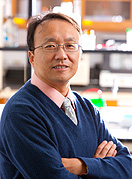News
Hindering plaque’s formation
is researcher’s goal
-
 Print
Print -
 Comments
Comments
-

Oral biologist Chris Li will use a $1.6 million grant from the National Institutes of Health to develop processes that may prevent biofilm formation of oral bacteria. Photo: DOUGLAS LEVERE
Human oral microbial biofilm is the plaque that dentists warn us about. Composed of numerous genetically distinct types of bacteria that live on host surfaces, these biofilms are essential for oral bacteria to adapt and thrive, and can cause oral infections.
UB researcher Chris (Chunhao) Li, assistant professor of oral biology in the School of Dental Medicine, has been awarded a $1.6 million research grant from the National Institutes of Health to develop processes that prevent biofilm formation of oral bacteria and possibly lead to therapeutic compounds.
Li’s quest to develop these processes begins with bacterial quorum-sensing systems that play a very important role in the formation and development of biofilm in numerous bacterial species, including oral bacteria.
“Quorum sensing is a type of bacterial cell-to-cell communication—a kind of decision-making process—and it is achieved through the production, release and detection of small signaling molecules called autoinducers (AIs),” said Li.
AIs come in two types and one of them has become the object of Li’s research. AI-2’s key biosynthesis enzyme is LuxS—whose quorum-sensing systems regulate a diverse group of activities in bacteria, including biofilm formation, and may be a potential molecular target for developing a novel class of therapeutic agents.
By defining the biochemical characteristics of LuxS proteins, Li hopes to identify compounds that are able to inhibit the biofilm formation of pathogenic oral bacteria.
The NIH-funded research may lead to better understanding of the biochemical features of LuxS proteins in oral bacteria, potentially creating new ways to prevent and treat oral microbial infections.

Reader Comments